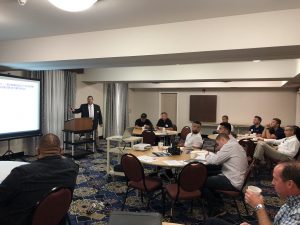WHAT TO DO WHEN YOU LOSE A BIG CLIENT?
Chris Anderson, Silvertrac Software
Meta Description: Losing a big client in a security company is a huge blow. However, evaluating the loss can help to improve the services that the company provides and reinforce positive relationships with current clients.
Losing a big client is a nightmare for any business, let alone a security company. Unfortunately, client loss is inevitable, but through analysis and strategy, it can be a great learning tool for bettering client relationships and service satisfaction.
There are many reasons why clients terminate a contract. They may be unhappy with the services provided. They may have found a better price point, or they may just not need the services any longer. When a contract terminates, it is important to look at the source of the termination to determine the cause.
Once you determine the root cause of why a client left, you can use this information to update your playbook to maintain current client standards and satisfaction.
Step 1: Termination Analysis
The goal of running a termination analysis is to determine the root cause of why a client left. This will give management a foundation for creating preventative measures for future churn.
Before jumping into the termination analysis, remember to keep the emotions in check. Of course, it is reasonable to be upset about losing a client, but entering into the conversation heated and angry is much more likely to result in a full loss of the professional relationship.
Respect the client’s views (even if you don’t agree), and don’t try to bully the client into staying. Use the termination analysis as a learning experience. If you can maintain a friendly relationship and update your services based on their feedback, there may be an opportunity to win the client back in the future.
1a – Schedule an Interview
The first step in termination analysis is scheduling an exit interview with the client. Remember, not every client is going to want to participate in an exit interview. Don’t pressure the client to attend an exit interview, and don’t pressure them to answer questions they don’t want to answer. Pressure alone can damage what is left of the relationship, beyond repair.
If the client is not particularly upset, their account manager should conduct the interview. Account managers are likely the most well-informed about the client’s contract and experience with the company.
If the client is very upset, it may be in the best interest of the company to have a supervisor conduct the exit interview. Having someone in a managerial position conduct the interview is likely going to make an angry client feel more important and cause less tension.
When designing the questions for the exit interview, there are a few key things that you will want to cover:
- Why did the client terminate the contract?
- How did the company contribute to the termination and client dissatisfaction?
- What could the company have done to prevent the termination?
There may be other questions that are pertinent to the analysis. However, it is important to keep the exit interview simple and to the point. Try not to ask any more than 5 questions. These questions will likely lead to a more open discussion as to what went wrong.
1b – Internal Audits and Quality Check
Once an exit interview has been conducted, all internal team members associated with the account should meet to discuss the exit interview and begin an internal audit and quality check. Team members may include security officers, supervisors, account managers, sales reps, and operations personnel.
Internal audits should focus on accountability, communication, and reporting protocols. Each team member should be able to provide a thorough account of their dealings with the client and any reports or documentation they have on the lost contract.
If they can’t provide this information, this is a big indicator of internal breakdown that likely played a big part in causing the termination.
Just like the exit interview, it is important that the internal-audit is an open discussion, not driven by emotion. It is important that all internal members feel heard and are given the space to communicate their interaction with the client.
Once the team has reviewed all of the exit interview questions and internal information, the audit should start to provide some insight into these types of questions:
- Was this a one-time incident or part of a bigger pattern?
- Were customer’s expectations understood?
- Where did the internal and/or external breakdown occur?
- What internal adjustments are required?
An organic termination roadmap of what/when things went wrong, what could have been done differently, what avenues of change are available moving forward, etc…will start to unveil itself as answers to these questions become clear.
Step 2: Post-Analysis Strategy Planning
As the termination roadmap becomes clear, the internal team should use this information to strategize what steps need to be taken to update company policy, process, services, and/or training to prevent future churn.
Both short and long term updates should be taken into consideration during this phase. Simple communication breakdowns and inaccurate reporting can be updated almost immediately, where process or policy updates that have cross-department effects may take longer to roll-out.
As necessary changes become clear, it is important to create a strategic plan to roll out each change with efficiency. Change can cause frustration and growing pains so the roll-out is equally as important as identifying necessary changes.
Once a plan is in place that the team feels will confidently diminish future client terminations, assigning a project manager is highly recommended, if they haven’t been assigned already. The project manager will maintain communication with the group, will ensure that all necessary deliverables are ready on-time, and will asses issues/challenges that need to be addressed as the roll-out is implemented.
As in any strategic planning, it is important to keep in mind that you will likely need to adjust the plan as it is rolled out. This is a normal and important part of strategizing. To account for these potential adjustments, it may be helpful to set-up check-in meetings with the appropriate team members.
Check-in meetings help to keep everyone up-to-date and allow the team to catch any issues as they happen. Without some sort of check-in plan, the team runs a much higher risk of missing critical things that may have longer-lasting effects. The company may just end up in a worse position than when they started the termination analysis.
Client Retention Reminders
Reminder 1: Appreciate Top Employees
Top employees help to enhance customer relationships and supplement great services. They are also the ones who often have the biggest influence over a client who is on the verge of terminating. Top employees are the backbone of successful companies.
Incentive programs are a great way to keep top-performers excited and engaged in the company. These programs can range from continued-education courses, leadership workshops, or even bonus incentives.
Performance goals and evaluations are also great ways to keep top-performers in the game. Hardworking employees are more often than not hungry for growth and promotions. Helping an employee to set KPIs confirms the company’s investment in the employee and makes the employee feel valued.
If you don’t acknowledge top-performing employees, they are likely going to leave for a company that will validate their skills and hard work. Don’t let the good employees getaway!
Reminder 2: Focus on Current Clients
Don’t get too lost in the termination-blues and forget about active clients. While it is important to run a thorough termination-analysis, if the team gets too bogged down in what has been lost, they are likely to forget about what they still have.
Utilize the termination-analysis to help foster better active-client relationships and increase their satisfaction. Using the termination-analysis as a guide is a great opportunity to set-up check-ins with active clients. Use these check-ins to make sure the client isn’t suffering from the same issues that caused the original churn.
It may be exactly what is needed to save another termination.
Reminder 3: Don’t get comfortable
There is always room for growth and improvement. Running one termination-analysis won’t solve all of the problems clients may be facing. Every client will have their own unique needs for contracting a company’s service and their own unique experience working with the company.
In addition to running a termination analysis on every churned contract, a company should also have reporting and business analysis exercises set-up so that they are consistently reviewing company progress and maintaining a pulse on client satisfaction.
The moment a company stops looking on where they can improve is the moment they start failing.
Losing a client is never fun, but it’s not the end of the world. Through termination-analysis and strategic planning, churn can be a great learning experience to help a company grow, foster better client relationships, and increase service satisfaction.
Chris is the Founder of Silvertrac Software and has been working in the security industry for more than 25 years. He enjoys working with our clients everyday to help them grow their businesses and really enjoy what they are doing. Chris currently lives and works in Seal Beach, CA.
 Jaimee K. Wellerstein is a Partner at Bradley & Gmelich LLP, and the Head of the firm’s Employment Department. Jaimee concentrates her practice in representing employers in all aspects of employment law, including defense of wage and hour class actions, PAGA claims, discrimination, retaliation, harassment, wrongful discharge, misclassification, and other employment related lawsuits. She also provides employment counseling and training in all of these areas.
Jaimee K. Wellerstein is a Partner at Bradley & Gmelich LLP, and the Head of the firm’s Employment Department. Jaimee concentrates her practice in representing employers in all aspects of employment law, including defense of wage and hour class actions, PAGA claims, discrimination, retaliation, harassment, wrongful discharge, misclassification, and other employment related lawsuits. She also provides employment counseling and training in all of these areas. Annette M. Barber is Special Counsel on Bradley & Gmelich LLP’s Employment Team. She represents clients providing employment advice and counsel in all aspects of hiring, performance management, training, compensation, and termination. Annette spent the past 17 years working with a global security company of 100,000 U.S. employees as an employment law attorney and then as Corporate Vice President directing HR Compliance nationwide for all 50 states, Puerto Rico and Guam.
Annette M. Barber is Special Counsel on Bradley & Gmelich LLP’s Employment Team. She represents clients providing employment advice and counsel in all aspects of hiring, performance management, training, compensation, and termination. Annette spent the past 17 years working with a global security company of 100,000 U.S. employees as an employment law attorney and then as Corporate Vice President directing HR Compliance nationwide for all 50 states, Puerto Rico and Guam.

 Named to IFSEC’s Global Influencers list 2018 for Security Thought Leadership, Mark is a business school graduate, CPP and Member of The Security Institute (MSyI). Mark’s background is in security services, corporate security, consulting and workforce software. A graduate of Concordia University in HR Management and International Business, he progressed to several senior management roles responsible for security business units across Canada, including serving as the Senior Manager for Corporate Security at Canada’s largest telecommunications company. He launched a consulting business focused on physical security for corporate clients, and has been teaching part-time at the Université de Montréal since 2016. Currently, Mark is the Vice-President, Security and Industry, in the software scaleup TrackTik, and volunteers as SRVP Region 6, Chair of the Security Services Council, the Private Security Officer Standard Technical Committee, and the Private Security Company (PSC.1) working group.
Named to IFSEC’s Global Influencers list 2018 for Security Thought Leadership, Mark is a business school graduate, CPP and Member of The Security Institute (MSyI). Mark’s background is in security services, corporate security, consulting and workforce software. A graduate of Concordia University in HR Management and International Business, he progressed to several senior management roles responsible for security business units across Canada, including serving as the Senior Manager for Corporate Security at Canada’s largest telecommunications company. He launched a consulting business focused on physical security for corporate clients, and has been teaching part-time at the Université de Montréal since 2016. Currently, Mark is the Vice-President, Security and Industry, in the software scaleup TrackTik, and volunteers as SRVP Region 6, Chair of the Security Services Council, the Private Security Officer Standard Technical Committee, and the Private Security Company (PSC.1) working group. Shaun Kelly joined Tolman & Wiker Insurance Services in 2005. He specializes in all lines of property and casualty insurance for industries including contract security firms, agriculture, construction, oil and gas. Shaun received a BS in Business Administration with a major in Finance from California State University in Fresno, California. He is an active member of several industry associations, including the Association CALSAGA, the Kern County Builders Exchange and the Independent Insurance Agents of Kern County. Shaun can be reached at 661-616-4700 or skelly@tolmanandwiker.com.
Shaun Kelly joined Tolman & Wiker Insurance Services in 2005. He specializes in all lines of property and casualty insurance for industries including contract security firms, agriculture, construction, oil and gas. Shaun received a BS in Business Administration with a major in Finance from California State University in Fresno, California. He is an active member of several industry associations, including the Association CALSAGA, the Kern County Builders Exchange and the Independent Insurance Agents of Kern County. Shaun can be reached at 661-616-4700 or skelly@tolmanandwiker.com.




